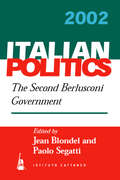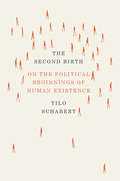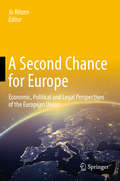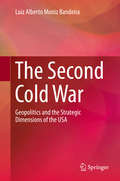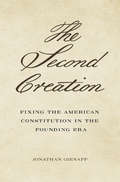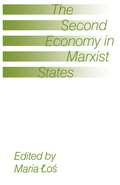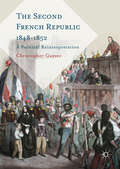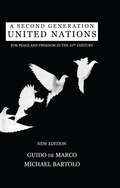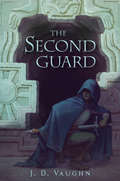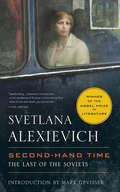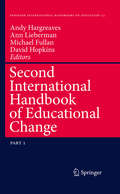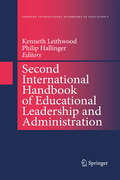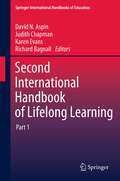- Table View
- List View
The Second Berlusconi Government (Italian Politics #18)
by Jean Blondel Pablo SegattiIn 2002, the second Berlusconi government, given its parliamentary strength, should have been able to implement its ambitious reform program. This 18th edition of Italian Politics examines the events of that year in light of the opportunities and the domestic and international constraints faced by Italy's center-right government. This volume discusses the actions of the Italian president, the prime minister's function within the cabinet, the overall behaviour of the government vis-á-vis Parliament, majority-opposition clashes in the legislature, foreign affairs, and economic and immigration policy. Moreover, the volume focuses on selected heated issues, including Berlusconi's conflict with the judiciary, reform of the labor market, evolution of banking foundations, and the crisis of Fiat, the nation's largest manufacturing group.
The Second Birth: On the Political Beginnings of Human Existence
by Tilo SchabertMost scholars link the origin of politics to the formation of human societies, but in this innovative work, Tilo Schabert takes it even further back: to our very births. Drawing on mythical, philosophical, religious, and political thought from around the globe—including America, Europe, the Middle East, and China—The Second Birth proposes a transhistorical and transcultural theory of politics rooted in political cosmology. With impressive erudition, Schabert explores the physical fundamentals of political life, unveiling a profound new insight: our bodies actually teach us politics. Schabert traces different figurations of power inherent to our singular existence, things such as numbers, time, thought, and desire, showing how they render our lives political ones—and, thus, how politics exists in us individually, long before it plays a role in the establishment of societies and institutions. Through these figurations of power, Schabert argues, we learn how to institute our own government within the political forces that already surround us—to create our own world within the one into which we have been born. In a stunning vision of human agency, this book ultimately sketches a political cosmos in which we are all builders, in which we can be at once political and free.
The Second Birth: On the Political Beginnings of Human Existence
by Tilo SchabertMost scholars link the origin of politics to the formation of human societies, but in this innovative work, Tilo Schabert takes it even further back: to our very births. Drawing on mythical, philosophical, religious, and political thought from around the globe—including America, Europe, the Middle East, and China—The Second Birth proposes a transhistorical and transcultural theory of politics rooted in political cosmology. With impressive erudition, Schabert explores the physical fundamentals of political life, unveiling a profound new insight: our bodies actually teach us politics. Schabert traces different figurations of power inherent to our singular existence, things such as numbers, time, thought, and desire, showing how they render our lives political ones—and, thus, how politics exists in us individually, long before it plays a role in the establishment of societies and institutions. Through these figurations of power, Schabert argues, we learn how to institute our own government within the political forces that already surround us—to create our own world within the one into which we have been born. In a stunning vision of human agency, this book ultimately sketches a political cosmos in which we are all builders, in which we can be at once political and free.
The Second Birth: On the Political Beginnings of Human Existence
by Tilo SchabertMost scholars link the origin of politics to the formation of human societies, but in this innovative work, Tilo Schabert takes it even further back: to our very births. Drawing on mythical, philosophical, religious, and political thought from around the globe—including America, Europe, the Middle East, and China—The Second Birth proposes a transhistorical and transcultural theory of politics rooted in political cosmology. With impressive erudition, Schabert explores the physical fundamentals of political life, unveiling a profound new insight: our bodies actually teach us politics. Schabert traces different figurations of power inherent to our singular existence, things such as numbers, time, thought, and desire, showing how they render our lives political ones—and, thus, how politics exists in us individually, long before it plays a role in the establishment of societies and institutions. Through these figurations of power, Schabert argues, we learn how to institute our own government within the political forces that already surround us—to create our own world within the one into which we have been born. In a stunning vision of human agency, this book ultimately sketches a political cosmos in which we are all builders, in which we can be at once political and free.
The Second Birth: On the Political Beginnings of Human Existence
by Tilo SchabertMost scholars link the origin of politics to the formation of human societies, but in this innovative work, Tilo Schabert takes it even further back: to our very births. Drawing on mythical, philosophical, religious, and political thought from around the globe—including America, Europe, the Middle East, and China—The Second Birth proposes a transhistorical and transcultural theory of politics rooted in political cosmology. With impressive erudition, Schabert explores the physical fundamentals of political life, unveiling a profound new insight: our bodies actually teach us politics. Schabert traces different figurations of power inherent to our singular existence, things such as numbers, time, thought, and desire, showing how they render our lives political ones—and, thus, how politics exists in us individually, long before it plays a role in the establishment of societies and institutions. Through these figurations of power, Schabert argues, we learn how to institute our own government within the political forces that already surround us—to create our own world within the one into which we have been born. In a stunning vision of human agency, this book ultimately sketches a political cosmos in which we are all builders, in which we can be at once political and free.
The Second Century: U. S. - Latin American Relations Since 1889 (PDF)
by Mark T. Gilderhus William H. Beezley Judith EwellThe Second Century: U.S.-Latin American Relations since 1889 focuses on U.S. relations with Latin America during the second century, a period bounded by the advent of the New Diplomacy late in the nineteenth century and the end of the Cold War about one hundred years later. This text provides a balanced perspective as it presents both the United States's view that the Western Hemisphere needed to unite under a common democratic, capitalistic society, and the Latin American countries' response to U.S. attempts to impose these goals on their southern neighbors. This book examines the reciprocal interactions between the two regions, each with distinctive purposes, outlooks, interests, and cultures. It also places U.S.-Latin American relations within the larger context of global politics and economics. The Second Century is an excellent text for courses in Latin American history and diplomatic history.
Second Chambers
by Nicholas Baldwin Donald ShellNotwithstanding the fact that among the parliaments of the world, 38 per cent have Second Chambers (67 out of 179), Second Chambers themselves have only rarely been the focus of attention from politicians and have almost totally been ignored by academics. This work sets about examining them.
Second Chambers
by Nicholas D.j. Baldwin Donald ShellNotwithstanding the fact that among the parliaments of the world, 38 per cent have Second Chambers (67 out of 179), Second Chambers themselves have only rarely been the focus of attention from politicians and have almost totally been ignored by academics. This work sets about examining them.
A Second Chance for Europe: Economic, Political and Legal Perspectives of the European Union
by Jo RitzenThis book calls upon us to rethink and reboot the European Union. The authors dissect the EU’s many vulnerabilities: how some Member States are backsliding on the rule of law, freedom of the press, and control of corruption – and how globalization’s ‘discontents’ are threatening the liberal international order. It examines the need for a common immigration policy; the need to rethink the unsustainable debt overhang of some Eurozone countries; and the need to use education to foster a European identity. Given the sum total of these vulnerabilities, the book argues, the EU may not survive beyond 2025 in its present form – that is, unless decisive action is taken. In turn, the book puts forward a number of workable solutions: a European economic model to secure full employment; a stronger European Court of Human Rights to counter systemic violations; a points-based immigration policy; clear exit options for the Eurozone; and an Open Education Area with a common second language. These solutions may reduce the number of EU countries, but would increase cohesion and overall survivability.
The Second Cold War: Geopolitics and the Strategic Dimensions of the USA
by Luiz Alberto Moniz BandeiraThis book investigates the geopolitics and strategic dimensions of US-American foreign policy during George W. Bush's and Barack Obama's presidential terms. Based on a vast amount of empirical and historical sources, the author offers deep insights into the recent political developments ('Arabellions') along the axis of Northern Africa, the Middle East, and Central Asia, situating them in the context of the global geopolitical and geo-economical Great Game, either latent or overt, between USA/NATO and Russia. The author also analyses the influence of the US on these historical and political processes in the last two decades.
The Second Creation: Fixing the American Constitution in the Founding Era
by Jonathan GienappAmericans widely believe that the U.S. Constitution was almost wholly created when it was drafted in 1787 and ratified in 1788. Jonathan Gienapp recovers the unknown story of the Constitution’s second creation in the decade after its adoption—a story with explosive implications for current debates over constitutional originalism and interpretation.
The Second Disestablishment: Church and State in Nineteenth-Century America
by Steven GreenDebates over the proper relationship between church and state in America tend to focus either on the founding period or the twentieth century. Left undiscussed is the long period between the ratification of the Constitution and the 1947 Supreme Court ruling in Everson v. Board of Education, which mandated that the Establishment Clause applied to state and local governments. Steven Green illuminates this neglected period, arguing that during the 19th century there was a "second disestablishment." By the early 1800s, formal political disestablishment was the rule at the national level, and almost universal among the states. Yet the United States remained a Christian nation, and Protestant beliefs and values dominated American culture and institutions. Evangelical Protestantism rose to cultural dominance through moral reform societies and behavioral laws that were undergirded by a maxim that Christianity formed part of the law. Simultaneously, law became secularized, religious pluralism increased, and the Protestant-oriented public education system was transformed. This latter impulse set the stage for the constitutional disestablishment of the twentieth century. The Second Disestablishment examines competing ideologies: of evangelical Protestants who sought to create a "Christian nation," and of those who advocated broader notions of separation of church and state. Green shows that the second disestablishment is the missing link between the Establishment Clause and the modern Supreme Court's church-state decisions.
The Second Disestablishment: Church and State in Nineteenth-Century America
by Steven GreenDebates over the proper relationship between church and state in America tend to focus either on the founding period or the twentieth century. Left undiscussed is the long period between the ratification of the Constitution and the 1947 Supreme Court ruling in Everson v. Board of Education, which mandated that the Establishment Clause applied to state and local governments. Steven Green illuminates this neglected period, arguing that during the 19th century there was a "second disestablishment." By the early 1800s, formal political disestablishment was the rule at the national level, and almost universal among the states. Yet the United States remained a Christian nation, and Protestant beliefs and values dominated American culture and institutions. Evangelical Protestantism rose to cultural dominance through moral reform societies and behavioral laws that were undergirded by a maxim that Christianity formed part of the law. Simultaneously, law became secularized, religious pluralism increased, and the Protestant-oriented public education system was transformed. This latter impulse set the stage for the constitutional disestablishment of the twentieth century. The Second Disestablishment examines competing ideologies: of evangelical Protestants who sought to create a "Christian nation," and of those who advocated broader notions of separation of church and state. Green shows that the second disestablishment is the missing link between the Establishment Clause and the modern Supreme Court's church-state decisions.
The Second Economy in Marxist States
by Maria LosThis book analyses and compares the unofficial economies and their control in ten marxist states: the USSR, Poland, Hungary, Romania, Yugoslavia, Cuba, Nicaragua, China, Angola and Tanzania. It provides a vivid, mosaic-like panorama of the hidden economies in these countries. The book breaks with the view that the unofficial economy is simply a by-product of the official economy. It shows an unfolding interplay between these two economies, which moulds and limits both the dynamics and the direction of the process of change. In her final essay, Maria Los develops a theoretical model linking second economies with the process of marxist economic development. The key stages of this process are identified as: (1) The stage of radical transformation; (2) The monopolisation period; (3) The reformist phase; and (4) Post- reformist decadence. The volume throws a new light on the prospects and problems of the reformist movements which have swept the Soviet Union, China and several other marxist states in the 1980s.
The Second French Republic 1848-1852: A Political Reinterpretation
by Christopher GuyverThis book follows the story of the Second French Republic from its idealistic beginnings in February 1848 to its formal replacement in December 1852 by the Second Empire. Based on original archival research, The Second French Republic gives a detailed account of the internal tensions that irrevocably weakened France’s shortest republic. During this short period French political life was buffeted by strong and often contrary forces: universal manhood suffrage, fear of socialism, the President Louis-Napoleon Bonaparte, and the political ambitions of the military high command for the restoration of the monarchy.
Second Generation United Nations
by Michael BartoloAs the United Nations moves beyond its fiftieth anniversary into the new millennium, it is faced with a new global system fraught with political and economic tensions that can no longer be handled with models that defined the organization when it was founded in 1945. An innovative vision for a restructuring of the United Nations, this book offers an insider's look at how the UN can respond more effectively to the challenges of the future in an age of globalization.
Second Generation United Nations
by Michael BartoloAs the United Nations moves beyond its fiftieth anniversary into the new millennium, it is faced with a new global system fraught with political and economic tensions that can no longer be handled with models that defined the organization when it was founded in 1945. An innovative vision for a restructuring of the United Nations, this book offers an insider's look at how the UN can respond more effectively to the challenges of the future in an age of globalization.
The Second Guard (A\second Guard Novel Ser. #1)
by J. D. VaughnIn the peaceful realm of Tequende, all second-born children must journey to the fantastical realm of Alcazar to fulfil the mandate of the Oath of Guilds as soon as they turn 15. There they train to earn a place among the queen's legendary second guard, or work as indentured servants. Talimendra has always wanted to join the guard, but there are dark rumours in the queendom that she may not be ready for. Rumours that whisper of greed, traitors and war.
Second-Hand Time: The Last of the Soviets
by Svetlana AlexievichIn Second-Hand Time, Alexievich chronicles the demise of communism. Everyday Russian citizens recount the past thirty years, showing us what life was like during the fall of the Soviet Union and what it’s like to live in the new Russia left in its wake. Through interviews spanning 1991 to 2012, Alexievich takes us behind the propaganda and contrived media accounts, giving us a panoramic portrait of contemporary Russia and Russians who still carry memories of oppression, terror, famine, massacres—but also of pride in their country, hope for the future, and a belief that everyone was working and fighting together to bring about a utopia. Here is an account of life in the aftermath of an idea so powerful it once dominated a third of the world. Alexievich’s distinctive documentary style, combining extended individual monologues with a collage of voices, records the stories of ordinary women and men who are rarely give the opportunity to speak, whose experiences are often lost in the official histories of the nation. Second-Hand Time will lead the South African reader to draw unexpected parallels with life after 1994.
Second Home Tourism in Europe: Lifestyle Issues and Policy Responses
by Zoran RocaBringing together a wide range of studies from twelve European countries, this book offers a state-of-the-art overview of the driving forces behind spatial diversity and social complexity inherent in second home expansion in all parts of the continent - from Scandinavia to the Mediterranean and from the British Isles to Russia - in the context of contemporary mobility patterns largely induced by tourism. As befits the overall conception of the book as a compendium of current second home research, planning and policy issues, the book endorses the following: multidisciplinary approaches to the second home phenomenon as an expression of the ’leisure class’ mobility and recreation-based lifestyles, as well as a constitutive element of post-productivist land-use patterns and landscape change; and socio-economic and territorial development planning and policy-related perspectives on social change and spatial re-organization provoked by the expansion of second home tourism in times of prosperity and crisis. ’This book shows that second home tourism has become such an important sector of the economy that it is no longer possible to let it develop freely: it is the source of new forms of social deprivation; it generates residential economies that are particularly sensitive to the economic cycle; it often impairs beautiful landscapes and increases human pressure on natural environments. As a result, it is one of the major physical planning stakes of touristic areas’ (From the concluding essay by Paul Claval, Université de Paris I - Sorbonne, Paris, France).
Second Home Tourism in Europe: Lifestyle Issues and Policy Responses
by Zoran RocaBringing together a wide range of studies from twelve European countries, this book offers a state-of-the-art overview of the driving forces behind spatial diversity and social complexity inherent in second home expansion in all parts of the continent - from Scandinavia to the Mediterranean and from the British Isles to Russia - in the context of contemporary mobility patterns largely induced by tourism. As befits the overall conception of the book as a compendium of current second home research, planning and policy issues, the book endorses the following: multidisciplinary approaches to the second home phenomenon as an expression of the ’leisure class’ mobility and recreation-based lifestyles, as well as a constitutive element of post-productivist land-use patterns and landscape change; and socio-economic and territorial development planning and policy-related perspectives on social change and spatial re-organization provoked by the expansion of second home tourism in times of prosperity and crisis. ’This book shows that second home tourism has become such an important sector of the economy that it is no longer possible to let it develop freely: it is the source of new forms of social deprivation; it generates residential economies that are particularly sensitive to the economic cycle; it often impairs beautiful landscapes and increases human pressure on natural environments. As a result, it is one of the major physical planning stakes of touristic areas’ (From the concluding essay by Paul Claval, Université de Paris I - Sorbonne, Paris, France).
Second Image IPE: Bridging the Gap Between Comparative and International Political Economy (International Political Economy Series)
by Andreas NölkeThis book argues that the lack of adequate theories of contemporary capitalism is due to the increasing separation of the sub-disciplines of Comparative and International Political Economy. Theorizing only takes place in one of the two over-specialized sub-disciplines of Political Economy, thereby leading to a neglect of the interplay between national and international dimensions of capitalism. The author seeks to rectify this gap by developing a theory of Second Image IPE. Based on the “second image” notion developed by Kenneth Waltz, he furthers the classical theoretical approaches as developed by Peter Gourevitch and Peter Katzenstein. For this purpose, he incorporates recent analytical developments in Comparative Capitalism and Growth Model analysis. The book demonstrates the usefulness of Second Image IPE theory by studying the major empirical topics of Global Political Economy, including security, finance, regional integration, trade, production and global order.
Second International Handbook of Educational Change (Springer International Handbooks of Education #23)
by David Hopkins Andy Hargreaves Michael Fullan Ann LiebermanThe two volumes of the second edition of the International Handbook of Educational Change comprise a totally new, and updated collection of the most critical and cutting-edge ideas in educational change. Written by the most influential thinkers in the field, these volumes cover educational change at both the theoretical and practical levels. The updated handbook remains connected to the classical concerns of the field, such as educational innovation, reform, and change management, and also offers new insights into educational change that have been brought about by social change and shifting contexts of educational reform. Like the first best selling Handbook, this one will also undoubtedly become an essential resource for people involved in all spheres of education, from classroom teachers, teacher leaders and administrators to educational researchers, curriculum developers, and university professors. No other work provides such a wide-ranging and comprehensive examination of the field of educational change.
Second International Handbook of Educational Leadership and Administration (Springer International Handbooks of Education #8)
by Kenneth A. Leithwood P. HallingerThe first International Handbook of Educational Leadership and Administration (Leithwood et al.) was published in 1996 and quickly became something of a best seller for reference works within education. Such success, we suggest, was at least partly due to the unprecedented global waves of concern for improving schools launched in the mid 1980's, combined with a widespread belief in leadership as the single most powerful contribution to such improvement. The roots of this belief can be found in evidence produced by the early "effective schools" research, although there is a "romance" with leadership! as an explanation for success in many non-school enterprises, as well. During the two-year period during which this current handbook was being written, activity in the realms of school leadership, school improvement, and leadership development gained further momentum. The English government created its new National College of School Leadership, and several Asian nations announced new initiatives in leadership selection, preparation, and development.
Second International Handbook of Lifelong Learning (Springer International Handbooks of Education #26)
by David N. Aspin, Judith Chapman, Karen Evans and Richard BagnallThe second edition of the International Handbook of Lifelong Learning is extensive, innovative, and international in scope, remit and vision, inviting its readers to engage in a critical re-appraisal of the theme of “lifelong learning”. It is a thorough-going, rigorous and scholarly work, with profound and wide-ranging implications for the future of educating institutions and agencies of all kinds in the conception, planning and delivery of lifelong learning initiatives. Lifelong learning requires a wholly new philosophy of learning, education and training, one that aims to facilitate a coherent set of links and pathways between work, school and education, and recognises the necessity for government to give incentives to industry and their employees so they can truly “invest” in lifelong learning. It is also a concept that is premised on the understanding of a learning society in which everyone, independent of race, creed or gender, is entitled to quality learning that is truly excellent.This book recognises the need for profound changes in education and for goals that are critically important to education, economic advancement, and social involvement. To those concerned about the future of our society, our economy and educational provision, this book provides a richly illuminating basis for powerful debate. Drawing extensively on policy analyses, conceptual thinking and examples of informed and world-standard practice in lifelong learning endeavours in the field, both editors and authors seek to focus readers' attention on the many issues and decisions that must be addressed if lifelong learning is to become a reality for us all.
